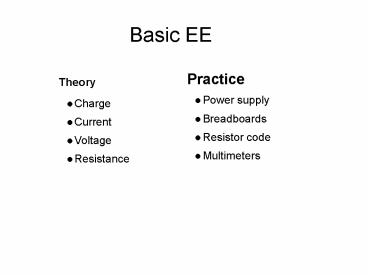Basic EE - PowerPoint PPT Presentation
Title:
Basic EE
Description:
Basic EE Practice Theory Power supply Breadboards Resistor code Multimeters Charge Current Voltage Resistance A property of particles that experience electromagnetic ... – PowerPoint PPT presentation
Number of Views:16
Avg rating:3.0/5.0
Title: Basic EE
1
Basic EE
Practice
Theory
- Power supply
- Breadboards
- Resistor code
- Multimeters
- Charge
- Current
- Voltage
- Resistance
2
Theory Charge
- A property of particles that experience
electromagnetic force - Two kinds of charge positive and negative
- Force due to charge obeys an inverse square law
- Charge is measured in coulombs
- Electrons and protons each have the same size
charge - (but of opposite polarity)
- Charge magnitude 1.6 10-19 coulombs
3
Theory Current
- Current is charge in motion
- Most of the time we think about electrons moving
- through metallic wires
- The flow rate of charge is measured in
couloumbs/second - or Amperes (Amps)
- charge/time couloumbs/sec Amperes
- 1 Amp (1/1.6) 1019 electrons / sec
4
Theory Voltage
- Voltage is the driving force behind current
- Voltage is the electrical potential energy a
charge has due to - its position in space
- potential energy per unit of charge
- "path independent
- Voltage is measured in Joules/Coulomb or Volts
(V) - Positive voltage is defined such that negatively
charged particles are - pulled towards higher voltages
- Potential energy can be converted into other
forms of energy
5
Theory Resistance
- Resistance is a property of materials
- Resistors are electrical components with known
resistance - Resistor code
- Resistors convert voltage to heat
- Ohm's law describes the relationship between
voltage and - current flow through a resistor
- V I R
- V is the voltage across the resistor
- I is the current flowing through the resistor
- R is the resistance (depends upon the material)
- Resistance is measured in Ohms, O
6
Practice Power Source
7
Practice Breadboard
8
Practice Resistor Code
9
Practice Multimeters
Voltage An across measurement
Current A through measurement
More detail on using multimeters































